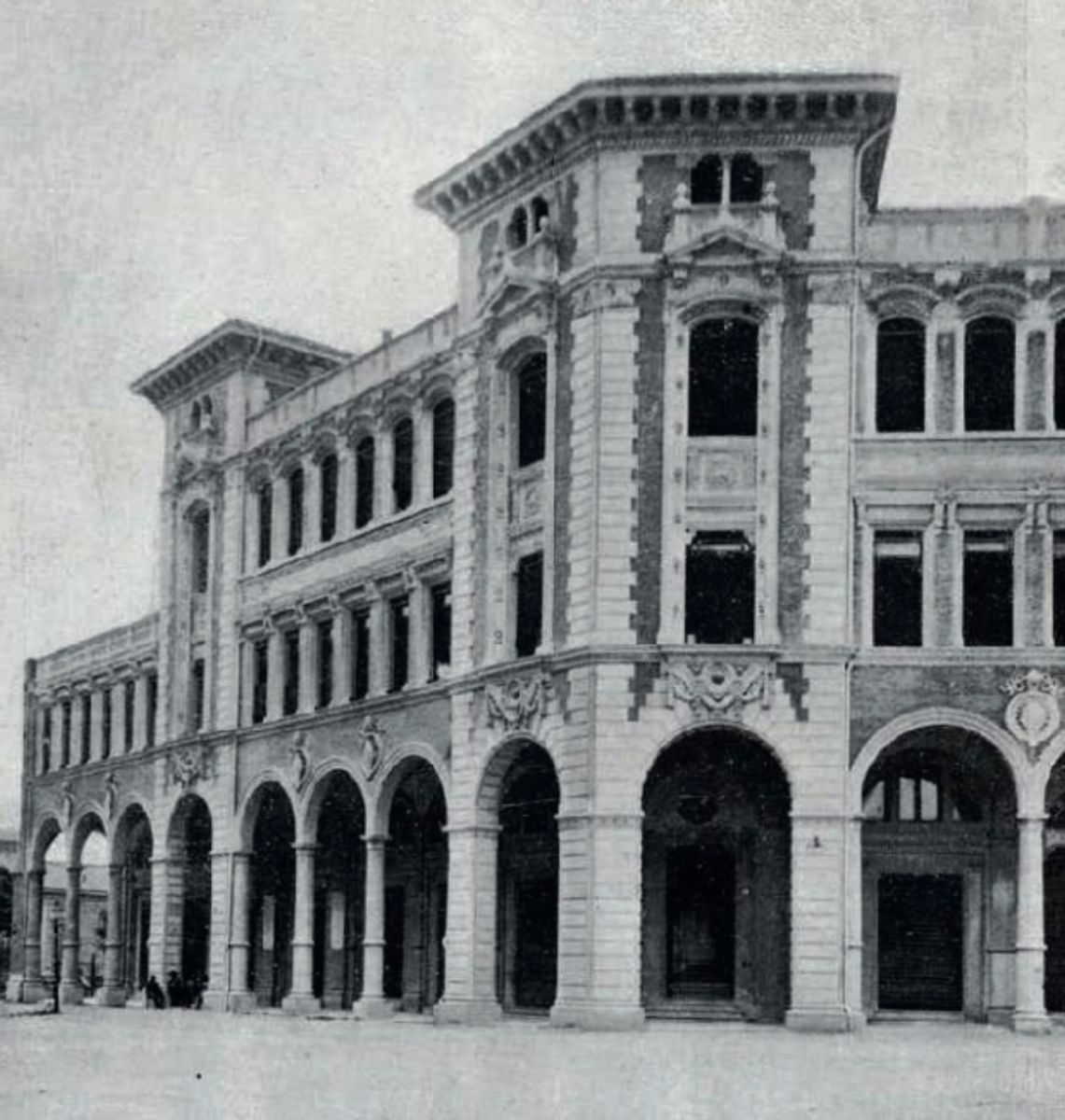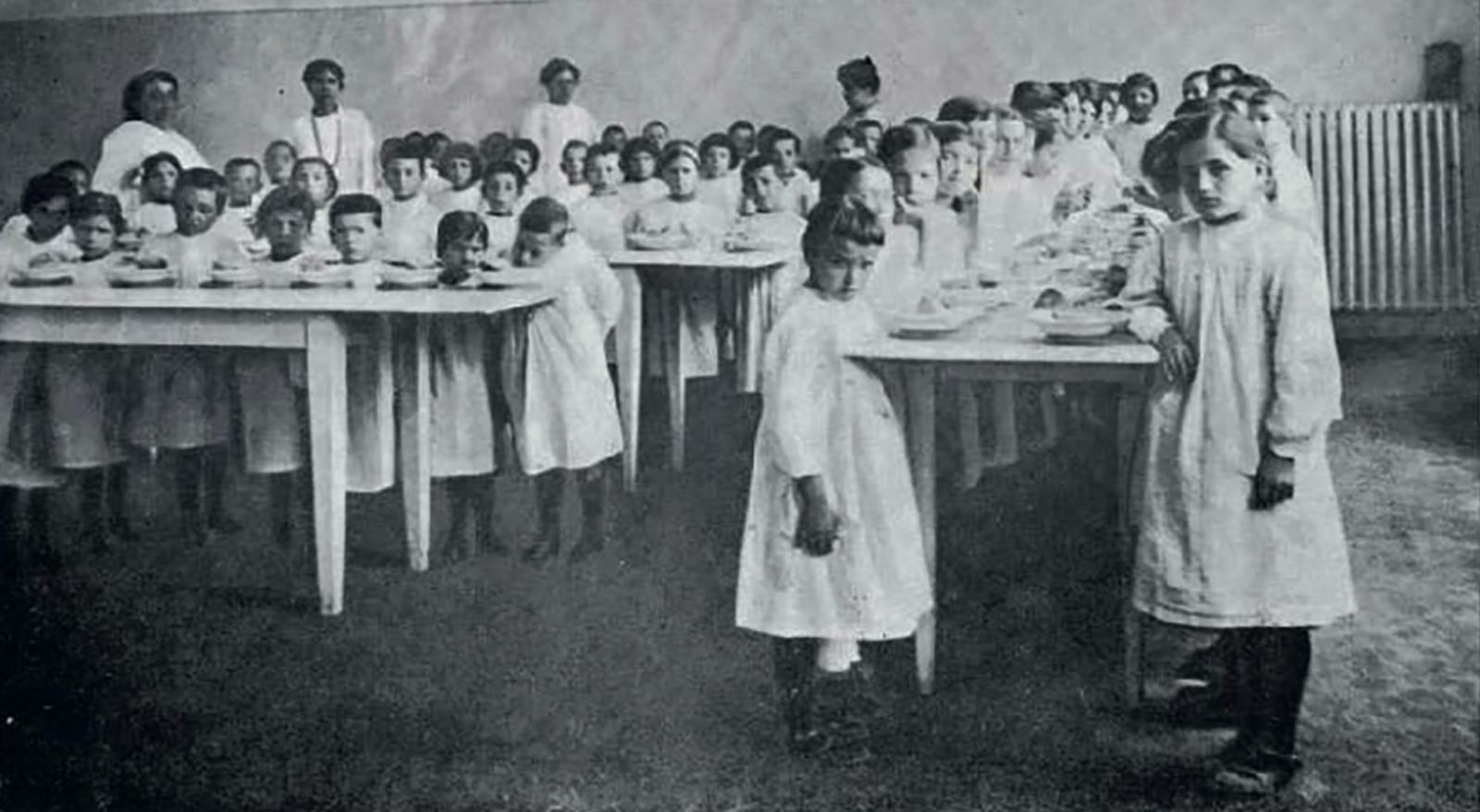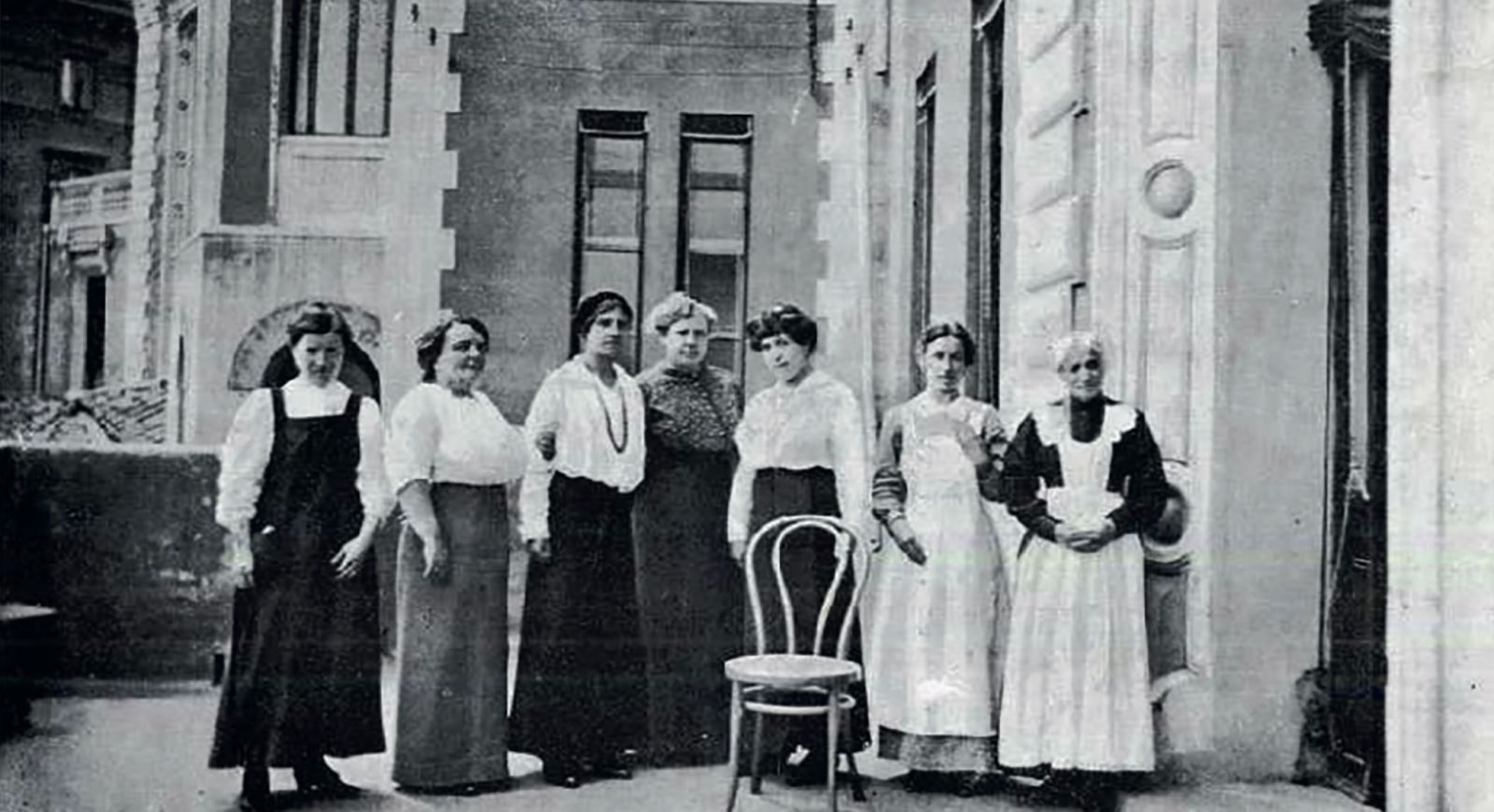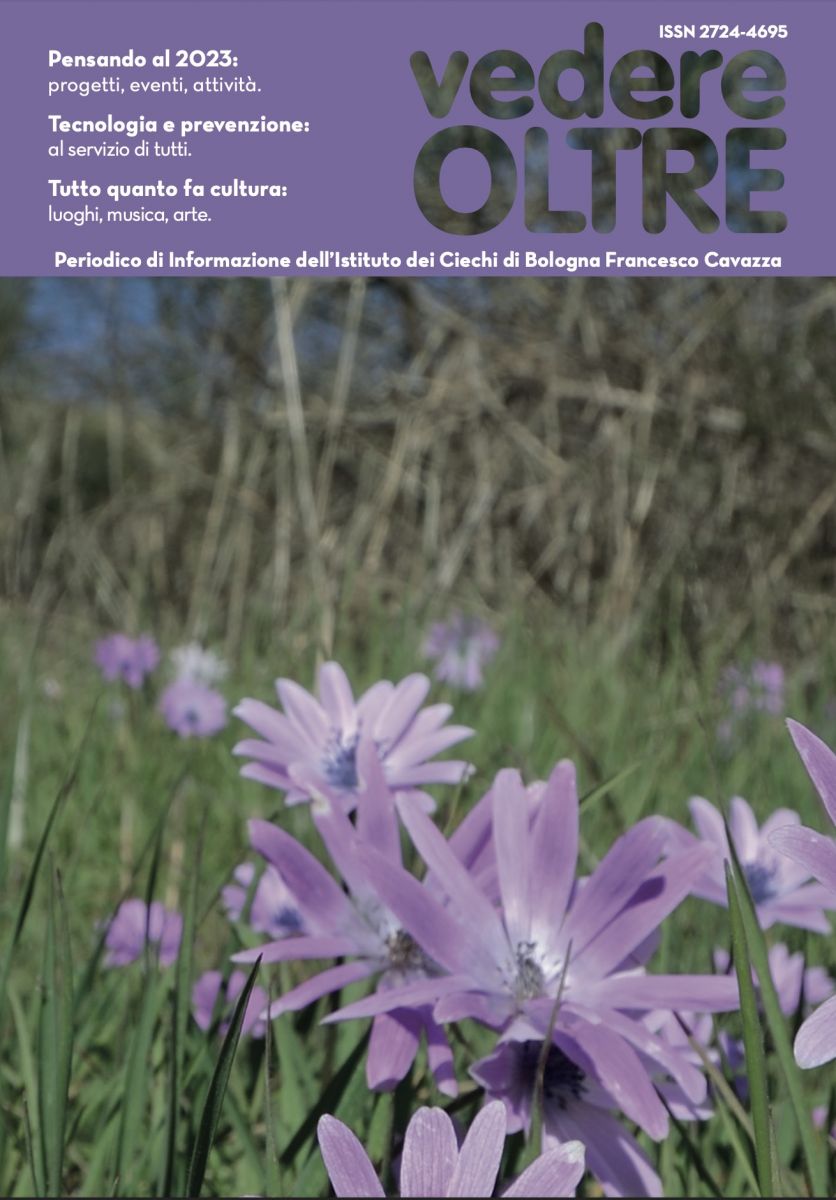On June 28, 1914, the socialist party led by Francesco Zanardi, who was to become mayor, won the local elections based on a programme of real change in the management of public affairs in favour of workers and on the belief that the municipality was “the truest Fatherland,” the collective patrimony and representation of all citizens, and an answer to the needs of social working classes. Reformist socialist policy was at “the centre of civic life and the synthesis and core of all life in the territory.” It brought new orientations and reference models for the emancipation of working women and men.  They meant good food at popular prices, products of quality, adequate housing, hygiene in homes and for the people, education and schooling for all, children’s camps, a fairer tax system. In short, all those achievements that are indispensable to reach the goal of social progress as the socialist election programme heralded in simple but meaningful words: “Bread and Alphabet.” The school is of particular interest for those innovations that characterized the activities of councillor Mario Longhena, a loyal collaborator of the mayor, who stated that when the war at the front “began its useless rhythm of death, life was reborn in all the schools in Bologna,” which did not close for a single day. The open-air school was a socialist experiment in elementary renewal that centered on nature from which to draw physical strength and studying and learning outside closed doors with feet firmly planted on the earth. All municipal educational institutions were open to girls and boys of all origins, an expression of equality and parity that the municipality recognizes in the field of education such as the camps. The permanent one in Casaglia for vulnerable children started its operations in 1918 and was inaugurated in 1919. At the end of the war, around six hundred Austrian children were accommodated there for four months to escape Vienna’s harsh winter of hunger and cold. There were school refreshments and after-school care for women with their husbands at work, but also before-school care for shift workers and after-school care for others; true full-time education, as well as popular courses, vocational schools, and the opening of five district libraries for reading and outreach. The innovations of a scholastic nature as a whole were not yet available in Bologna, but an important direction was taken in the foundation of special schools dedicated to the integration of schoolchildren who had been excluded, a problem raised as far back as 1908 by councillor Ettore Zanardi, founder of the Budrio sanatorium and a convinced advocate of moral and physical hygiene. He asked the municipal council for a special fund to set up a school for children with trachoma which would respond to a very urgent need, “which will not lack the support of the entire citizenry.”1
They meant good food at popular prices, products of quality, adequate housing, hygiene in homes and for the people, education and schooling for all, children’s camps, a fairer tax system. In short, all those achievements that are indispensable to reach the goal of social progress as the socialist election programme heralded in simple but meaningful words: “Bread and Alphabet.” The school is of particular interest for those innovations that characterized the activities of councillor Mario Longhena, a loyal collaborator of the mayor, who stated that when the war at the front “began its useless rhythm of death, life was reborn in all the schools in Bologna,” which did not close for a single day. The open-air school was a socialist experiment in elementary renewal that centered on nature from which to draw physical strength and studying and learning outside closed doors with feet firmly planted on the earth. All municipal educational institutions were open to girls and boys of all origins, an expression of equality and parity that the municipality recognizes in the field of education such as the camps. The permanent one in Casaglia for vulnerable children started its operations in 1918 and was inaugurated in 1919. At the end of the war, around six hundred Austrian children were accommodated there for four months to escape Vienna’s harsh winter of hunger and cold. There were school refreshments and after-school care for women with their husbands at work, but also before-school care for shift workers and after-school care for others; true full-time education, as well as popular courses, vocational schools, and the opening of five district libraries for reading and outreach. The innovations of a scholastic nature as a whole were not yet available in Bologna, but an important direction was taken in the foundation of special schools dedicated to the integration of schoolchildren who had been excluded, a problem raised as far back as 1908 by councillor Ettore Zanardi, founder of the Budrio sanatorium and a convinced advocate of moral and physical hygiene. He asked the municipal council for a special fund to set up a school for children with trachoma which would respond to a very urgent need, “which will not lack the support of the entire citizenry.”1
There were an estimated two hundred children suffering from trachoma, a public health problem that, if neglected, leads to blindness. Trachoma is contagious for people living in the same household to such an extent that it has become endemic, and its prevalence has not diminished over the years despite all the care of specialists and school doctors, “Perhaps not because of ill-will on the part of men, but because of a lack of vision of the complex problem of schools.”2 
Trachoma predominantly affects the poor classes and progresses in children compelled to live in unhygienic dwellings and physically challenged by poor nutrition. The newly established socialist administration was concerned with setting up both an open-air school– the future pavilion named after Fernando Fortuzzi in the Margherita Gardens in 1917, to continue the plan of guaranteeing hygiene and education– and the opening of a school that, “furnished in a very special way, could accommodate all those children who, suffering from trachoma, in addition to the very serious threat of blindness, are excluded from all schools, because they are contagious and therefore forced into the misery of ignorance.”3 The municipal school for trachomatous children was inaugurated on Sunday, December 6, 1914, in the new premises of the Poliambulanza Felsinea in Piazza Umberto I, number 1 4 by Mayor Francesco Zanardi and Education Councillor Mario Longhena in the presence of the highest authorities because it is the duty “of a Democratic State to provide for the education of all citizens.”5 The school was a model of care for patients suffering from this acute form of conjunctivitis and ensured not only education, but daily medical eye care by the Poliambulanza ophthalmologists themselves– in particular Dr. Antonio Nigrisoli and Dr. Uberto Sarti– and hygienic supervision by the health officer and school doctors.6 The new premises were filled with air and light, and furnished by the Cappelli Bookshop, which contributed by supplying special benches for trachoma children. A special varnish on these benches allowed the most thorough disinfection. All other school furnishings– cupboards, coat racks, tables– were also manufactured in such a way as to be resistant to frequent washing and to maintain hygiene standards.7
 Teaching was carried out by the municipality’s teachers under the direction of Miss Lusertini, with a similar programme to that of the other schools, but at a slower pace to adapt to the difficulties of the children with eye problems and to promote better learning. The lesson schedule was shorter, with relatively long and frequent intervals between classes. The school was open every day except Sunday with a daily attendance that favoured care and compliance with the rules of open-air schools so that sick children enjoyed fresh air as long as possible. Healthy, balanced, and plentiful food was served three times a day with a marked improvement in the living conditions, environment, and nutritional status of trachomatous children. With this method of treatment, much better results were achieved in a relatively short time because of the many cures and significant benefits for young patients. On the same days as the inauguration, Councillor Longhena, on behalf of the Council, proposed naming the school of trachomatous children after Augusto Murri with these motivations: “Naming an institute after Augusto Murri is a consecration of its scientific value; naming the institute whose aim is the care and protection of children after him is fitting because no one is unaware that Augusto Murri donated a considerable part of his fortune to the Marini Hospices.”8
Teaching was carried out by the municipality’s teachers under the direction of Miss Lusertini, with a similar programme to that of the other schools, but at a slower pace to adapt to the difficulties of the children with eye problems and to promote better learning. The lesson schedule was shorter, with relatively long and frequent intervals between classes. The school was open every day except Sunday with a daily attendance that favoured care and compliance with the rules of open-air schools so that sick children enjoyed fresh air as long as possible. Healthy, balanced, and plentiful food was served three times a day with a marked improvement in the living conditions, environment, and nutritional status of trachomatous children. With this method of treatment, much better results were achieved in a relatively short time because of the many cures and significant benefits for young patients. On the same days as the inauguration, Councillor Longhena, on behalf of the Council, proposed naming the school of trachomatous children after Augusto Murri with these motivations: “Naming an institute after Augusto Murri is a consecration of its scientific value; naming the institute whose aim is the care and protection of children after him is fitting because no one is unaware that Augusto Murri donated a considerable part of his fortune to the Marini Hospices.”8
The results obtained by the school of trachomatous children, inaugurated by the municipality in 1914, and one of the few existing in other cities in Italy, guaranteed the childcare assistance strongly supported by Bologna’s first socialist administration to guarantee education for all in favour of a social renewal that did not exclude the children of workers and the poorer social classes.
1. Bologna Municipal Council, sitting of December 22, 1908, Ettore Zanardi– Recommendation for the establishment of a school for children suffering from trachoma and a medical school for disabled children. Pro-mayor Giuseppe Tanari replies that following a request made in this regard by Poliambulanza Felsinea, the Council was quick to assure it that the municipality would grant a subsidy of 34,000 lire for the establishment of said school and allocated 17,000 lire. He assures that the new school buildings that are being constructed will be completed and will provide suitable premises for the purpose. Ettore Zanardi died on August 11, 1910, and was commemorated in the Bologna City Council on November 21, 1910: “He worked on moral and physical health and offered a wealth of love and energy to the Budrio Sanatorium, which was not least the object of his fervent mission.”
2. Mario Longhena, educators and summer camps, in La Vita Cittadina, Municipality of Bologna, Monthly Bulletin, June 1914.
3. Ibidem.
4. Now Martyrs’ Square; the buildings of the Poliambulanza Felsinea and the municipal school for trachomatous children were bombed during the Second World War 1943-1945.
5. The municipal school for trachomatous children, in Il Resto del Carlino – La Patria, December 5, 1914. 6. Mario Longhena, educators and summer camps, cit.
7. Inauguration of the municipal school for trachomatous children, in Il Resto del Carlino – La Patria, December 7, 1914.
8. Bologna Municipal Council, December 9, 1914.





.png)